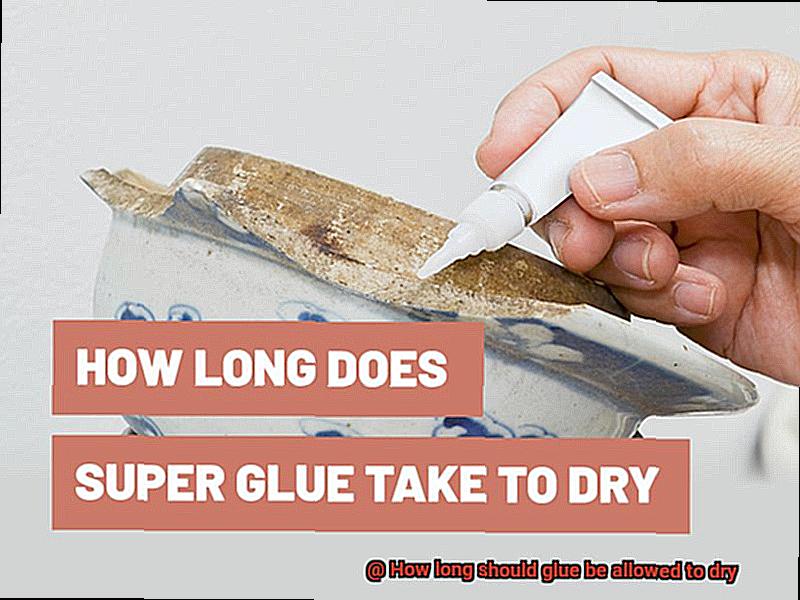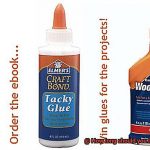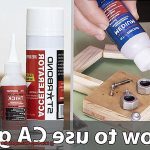Ever wondered, “How long should I wait for this glue to dry?” We’ve all been there. Whether you’re crafting or fixing something, knowing the optimal drying time is crucial. In this blog post, we’ll dive into the fascinating world of glue drying and uncover the secrets behind the perfect waiting period. So grab a drink, sit back, and let’s embark on a journey of sticky discoveries.
Glue drying isn’t an exact science. Different glues have different drying times, and factors like temperature and humidity can affect them too. But it’s not just about waiting for it to harden; glue goes through chemical reactions that turn it from liquid to solid. During this process, there’s an “open time” where you can adjust your project before it sets completely.
Temperature and humidity play big roles in glue drying time. Warmer conditions speed things up, while chillier or humid environments slow them down. So remember, patience is key.
In this blog post, we’ll explore various types of glues and their recommended drying times. We’ll also share tips on how to speed up or slow down the process as needed. And don’t worry—we’ll debunk common misconceptions and help you ensure your glue bonds last.
Whether you’re a crafter or a DIY enthusiast, this blog post will give you the knowledge and confidence to conquer your projects with expertise. Get ready to demystify the art of waiting for glue to dry and take your glue-bonding adventures to new heights.
Types of Glue and Their Drying Times
Contents
- 1 Types of Glue and Their Drying Times
- 2 Following the Manufacturer’s Instructions
- 3 Factors Affecting Drying Time
- 4 Considerations for Different Materials Being Bonded
- 5 Testing the Bond Strength Before Relying on the Glued Item
- 6 Allowing Extra Time for Critical Projects
- 7 Curing and Strengthening Over Time
- 8 The Importance of Patience
- 9 Conclusion
Glue comes in various types, each with its own unique properties and drying times. The choice of glue depends on the materials being bonded and the specific requirements of the project. Here are some common types of glue and their respective drying times:
- White Glue: Also known as school glue or PVA glue, white glue is a popular choice for general crafting and household repairs. It is water-based and typically dries within 30 minutes to an hour. However, it may take longer to fully cure and achieve maximum strength. To ensure a strong bond, it is best to wait at least 24 hours before subjecting the bonded pieces to stress or load.
- Wood Glue: Specifically designed for bonding wood surfaces, wood glue is usually stronger than white glue. It can take anywhere from 30 minutes to several hours to dry. However, it is advisable to wait at least 24 hours before subjecting the bonded pieces to stress or load. This gives the glue enough time to fully cure and create a robust bond.
- Super Glue: Also known as cyanoacrylate adhesive, super glue is a fast-drying adhesive that forms an instant bond. It usually dries within seconds to a few minutes, making it ideal for quick repairs or bonding small items. However, it may take up to 24 hours to reach its full strength. So, while the initial bond may be strong, it’s best to give it some extra time to fully cure for maximum durability.
- Epoxy: Epoxy is a two-part adhesive consisting of a resin and a hardener. It offers exceptional bonding strength and versatility, making it suitable for various materials such as metal, plastic, and glass. The drying time for epoxy can range from a few minutes to several hours, depending on the specific product and application. To ensure a strong bond, allow the epoxy to cure for at least 24 hours before subjecting it to any stress or load.
- Hot Glue: Hot glue is a thermoplastic adhesive that is melted using a hot glue gun. It sets quickly upon cooling and can be used for a wide range of applications, including crafts, decorations, and minor repairs. The drying time for hot glue is almost instantaneous, but it may take a few minutes to fully harden. It’s important to note that hot glue may not provide as strong of a bond as other types of glue, so it’s best suited for temporary or less demanding projects.
Remember that the drying time of glue can be influenced by various factors, including temperature, humidity, and the thickness of the adhesive layer. Following the manufacturer’s instructions and allowing sufficient drying and curing time will ensure optimal bonding results.
Following the Manufacturer’s Instructions
When it comes to using glue, following the manufacturer’s instructions is absolutely vital for success. Not only does it ensure optimal bonding, but it also takes into account material compatibility, environmental factors, and additional precautions. Let’s dive deeper into these reasons to understand why adhering to the instructions is crucial.
- Optimal Bonding: The manufacturer’s instructions provide valuable guidance on drying time, which is essential for achieving optimal bonding. Each type of glue has its own specific drying time, and deviating from these instructions can lead to weak joints or subpar bonding. By following the recommended drying time, you allow the adhesive to set properly and form a strong bond.
- Material Compatibility: The manufacturer’s instructions also consider the materials being bonded. Different materials require different drying times to ensure proper adhesion. By following the instructions, you prevent any potential issues that may arise from incompatible drying times. This ensures that your bond is strong and long-lasting.
- Environmental Factors: Temperature and humidity are important environmental factors that significantly affect glue drying time. The manufacturer’s instructions take these factors into account and provide recommendations accordingly. By following the recommended drying time, you create the optimal conditions for glue to dry effectively and form a strong bond.
- Additional Precautions: Manufacturer’s instructions often include additional steps or precautions to take during the drying process. Some glues may require applying pressure or clamping the bonded materials together while they dry. Others may specify a specific temperature range for optimal results. Following these precautions ensures that the glue dries properly and achieves its maximum strength.
- Patience is Key: Rushing the drying process can jeopardize the integrity of the bond and result in a weaker joint. Applying excessive heat or force may seem tempting, but it can compromise the overall effectiveness of the adhesive. By patiently allowing the glue to dry according to the manufacturer’s instructions, you ensure that it fully cures and reaches its maximum bonding strength.

Factors Affecting Drying Time
When it comes to glue, the drying time is influenced by a variety of factors. By understanding these factors, you can plan your projects accordingly and achieve the best results. Let’s explore the key factors that affect the drying time of glue:
- Type of Glue: Different types of glue have varying drying times. Super glue or cyanoacrylate adhesive, for example, dries in a flash, often within seconds. On the other hand, white glue or wood glue typically takes longer to dry, ranging from a few minutes to several hours. It’s crucial to consider the specific type of glue you’re using and adhere to the manufacturer’s instructions for optimal drying time.
- Temperature and Humidity: The interplay between temperature and humidity significantly impacts the drying process of glue. Higher temperatures generally expedite drying time, while lower temperatures slow it down. Likewise, low humidity levels accelerate drying, whereas high humidity prolongs it. To achieve optimum drying results, it’s advisable to work in a well-ventilated area with moderate temperature and humidity conditions.
- Thickness of Glue Application: The thickness of the glue application also affects drying time. Thicker layers or larger amounts of glue naturally require more time to dry compared to thin layers or small amounts. It’s important to apply an even layer of glue and avoid excessive amounts, especially when working on projects that demand quick drying.
- Porosity of Materials: The porosity of the materials being glued together can impact drying time as well. Porous materials like wood or fabric tend to absorb moisture from the glue, lengthening the drying process. Non-porous materials such as glass or metal do not absorb moisture, allowing for faster drying. When working with different materials, it’s crucial to consider their porosity and adjust your expectations for drying time accordingly.
- Ventilation: Proper ventilation is essential for efficient glue drying. Adequate airflow helps remove moisture from the glue, expediting the drying process. Working in a well-ventilated area or utilizing fans to facilitate air circulation is recommended. However, exercise caution with fans, as they may cause the glue to dry too quickly, potentially compromising the bond.
- Application Method: The method of applying glue can also influence drying time. Brushing or spreading glue over a larger surface area generally requires more time to dry compared to pinpoint application using a nozzle or fine applicator. Consider the project requirements and adjust your application method accordingly to achieve the desired drying time.
- Curing Time: While drying time refers to the initial setting and hardening of the glue, curing time pertains to the complete bonding and strengthening of the adhesive. Some glues may appear dry on the surface but still require additional time to fully cure. It’s crucial to follow the manufacturer’s instructions regarding both drying and curing times to ensure optimal results.
Considerations for Different Materials Being Bonded
When it comes to bonding different materials together using glue, there are several considerations that must be taken into account to achieve optimal results. These considerations include the type of materials being bonded, their porosity and surface condition, temperature and humidity levels, the type of glue used, and the size and weight of the objects being bonded.
Firstly, the porosity of the materials is an important factor to consider. Porous materials, such as wood or fabric, tend to absorb glue more quickly compared to non-porous materials like metal or glass. The absorption rate can vary depending on the density and composition of the material. For example, softwoods may absorb glue faster than hardwoods due to their open cell structure. It is essential to choose a glue that is suitable for the porosity of the materials being bonded.
Secondly, the surface condition of the materials is another crucial consideration. Smooth surfaces typically require less drying time as they offer less resistance for the glue to adhere. In contrast, rough or uneven surfaces may require more drying time to ensure a strong bond. Properly preparing the surfaces by cleaning and sanding them if necessary can enhance the bond strength and reduce drying time.
Additionally, temperature and humidity play a significant role in the drying time of glue. Most glues dry faster in warm and dry environments compared to cold and humid conditions. Higher temperatures can accelerate the evaporation of moisture from the glue, resulting in a quicker drying process. Conversely, low temperatures or high humidity levels can slow down the drying time significantly. It is important to choose an appropriate environment for bonding and consider temperature and humidity control measures if necessary.
The type of glue being used is another critical consideration. Different types of glues have varying drying times and recommended curing periods. Some glues, such as cyanoacrylate (super glue), can dry within seconds or minutes, while others like epoxy adhesives may require several hours or even overnight to fully cure. It is essential to follow the manufacturer’s instructions regarding drying and curing times for optimal bonding results.
Furthermore, the size and weight of the objects being bonded can affect the drying time. Larger or heavier objects may require longer drying periods to ensure a secure and durable bond. Providing sufficient support or clamping during the drying process can prevent any movement or shifting that could compromise the bond.
Testing the Bond Strength Before Relying on the Glued Item
Testing the bond strength before relying on a glued item is not only important, but crucial to ensure its durability and reliability. A weak bond can lead to catastrophic failures and potential safety hazards. Therefore, it is essential to follow a step-by-step process in order to effectively test the bond strength and make informed decisions about the reliability of the glued item.
Firstly, applying pressure or stress to the glued area is an initial indicator of the bond strength. Gently pulling or twisting the glued parts will reveal if they hold together firmly. It is important to assess any signs of cracking, peeling, or separation, as these are clear indications of a weak bond.
Furthermore, considering the drying time of the glue is imperative. Different glues have varying drying times and levels of strength. It is crucial to follow the manufacturer’s instructions regarding drying time for optimal results. Some glues may require longer drying times to achieve maximum bond strength.
Additionally, subjecting the glued item to various environmental conditions helps evaluate how well the glue holds up and maintains its bond strength. Exposing it to heat, moisture, or extreme temperatures will provide valuable insights into its reliability under different circumstances.
In some cases, performing destructive testing may be necessary. This involves intentionally breaking or pulling apart the glued parts to assess their bond strength. However, caution must be exercised during this process, especially if the item is valuable or difficult to replace.
Assessing the results of these tests is vital. If the bonded parts fail any of these tests, it indicates a weak bond. In such cases, reapplying glue, using a different type of adhesive, or reinforcing the bonded area with additional support or fasteners are potential solutions.
Allowing Extra Time for Critical Projects
Allowing extra time for critical projects that involve glue drying is essential for several reasons. Rushing the drying process can compromise the integrity and strength of the bond, which is particularly crucial in projects where safety is a concern, such as constructing furniture or building structures. To determine the appropriate drying time, consider the type of glue being used. Different adhesives have different drying times, so it is important to follow the manufacturer’s instructions. Super glue or cyanoacrylate adhesive typically dries within seconds or minutes, while wood glue or epoxy may require several hours or even days to fully cure.
Environmental conditions also play a significant role in the drying time of glue. Higher temperatures accelerate drying, while lower temperatures slow it down. Low humidity levels facilitate faster drying, while high humidity prolongs the process. Adequate airflow helps remove moisture and aids in evaporation.
It is advisable to allocate more time than recommended by the manufacturer to account for unforeseen circumstances. Rushing the process can result in weak joints or project failure. Additionally, certain materials or surfaces may require extended drying times due to their porosity or composition. For example, porous materials like wood may absorb more moisture from the glue, necessitating longer drying periods.
Curing and Strengthening Over Time
The process of curing and strengthening glue over time is influenced by various factors, including temperature, humidity, and specific glue formulas. Understanding these factors is crucial for ensuring successful and durable projects. Let’s delve into each factor to gain a deeper understanding:
Temperature plays a significant role in the drying and curing of glue. Warmer temperatures accelerate chemical reactions, expediting the curing process. Conversely, colder temperatures slow down the process. However, extreme temperatures can have adverse effects on glue performance, so it’s essential to work within the recommended temperature range specified by the manufacturer.
Humidity levels also impact the drying and curing of glue. High humidity slows down moisture evaporation, prolonging drying time. On the other hand, low humidity can cause the glue to dry too quickly, leading to weak bonds. Striking a balance in humidity levels is essential for optimal results.
Different glues have unique formulas that affect their curing and strengthening properties. Some glues are designed for fast-drying applications, while others require longer curing times for stronger and more durable bonds. It’s important to choose a glue that aligns with your project requirements and follow the manufacturer’s instructions regarding drying and curing times.
To ensure proper curing and strengthening of glue over time, allow sufficient time for the glue to fully cure before subjecting it to stress or load. Rushing the process can compromise the bond’s integrity. Remember that most glues require at least 24 hours to reach their maximum strength.
By considering temperature, humidity, and specific glue formulas in your projects, you can guarantee successful outcomes. Take into account these factors and provide proper ventilation during the curing process. Avoid disturbing glued surfaces, as this can weaken the bond and prolong drying time.
It is also worth noting that factors such as thickness of the glue layer, type and porosity of materials being bonded, and environmental conditions can affect drying time. Follow the manufacturer’s instructions and exercise caution when using accelerators to speed up the curing time, as they may impact the overall strength and performance of the glue.
The Importance of Patience
Patience is not only essential when it comes to allowing glue to dry properly, but it is also a virtue that can have a profound impact on various aspects of our lives. Whether we’re waiting for glue to dry, waiting for a project to come to fruition, or waiting for personal growth and development, patience is the key ingredient that allows us to achieve success and satisfaction.
One of the main reasons why patience is important is that it allows us to make better decisions. When we rush into things without taking the time to thoroughly evaluate our options, we often end up making hasty choices that we later regret. Patience gives us the opportunity to consider all the factors at play, weigh the pros and cons, and make informed decisions that align with our long-term goals.
Furthermore, patience enables us to persevere through challenges and setbacks. In today’s fast-paced society, we are often conditioned to expect instant gratification. However, success rarely comes overnight. It takes time and effort to achieve our goals. During this journey, there will inevitably be obstacles and setbacks that test our resolve. Patience allows us to stay focused and committed, even when things aren’t going according to plan.
In addition, patience fosters better relationships. Relationships require time and effort to grow and thrive. By being patient with others, we give them the space they need to express themselves, make mistakes, and learn from them. We also become more understanding and empathetic towards their struggles and challenges. This cultivates trust and deepens our connections with others.
Lastly, patience promotes self-growth and personal development. True growth takes time. Whether it’s developing a new skill, overcoming a fear, or working towards personal goals, progress occurs gradually. Patience allows us to embrace the process of growth with grace and acceptance. It helps us appreciate the journey rather than solely focusing on the end result.
U0hhFjjW5EU” >
Conclusion
When it comes to allowing glue to dry, patience is key. The drying time can vary depending on the type of glue and the materials being bonded together. In general, most glues require at least 24 hours to fully dry and cure. However, it’s always best to consult the manufacturer’s instructions for specific drying times.
During the drying process, it’s crucial to ensure that the glued objects are held firmly in place. This can be achieved by using clamps, weights, or tape. Applying pressure helps create a strong bond and prevents any shifting or misalignment.
While waiting for the glue to dry, it’s important to resist the temptation to rush things. Prematurely disturbing or manipulating the glued objects can weaken the bond and result in a subpar outcome.
Additionally, environmental factors play a role in drying time. Factors such as temperature and humidity can affect how long it takes for glue to fully set. Warmer temperatures generally speed up drying time, while cooler temperatures slow it down.
To ensure optimal results, it’s recommended to give the glue ample time to dry beyond its minimum required drying time. This extra time allows for complete curing and ensures a strong and durable bond.
In conclusion, when working with glue, patience truly pays off. Allowing sufficient drying time is essential for achieving a successful bond between materials.






